
Period poverty is the inability of some people to access adequate menstrual products.
Unfortunately, period poverty affects more women than you can imagine. Even worse, it causes physical, emotional, and mental challenges to these women.
Although it is so common, people don’t talk about it because of the stigma it causes.
Even sadly, we don’t raise awareness well enough for period poverty. It is so common that at least one woman you meet daily cannot afford menstrual kits.
Let’s take a deeper look at how and whom period poverty affects.
Hopefully, these period poverty statistics will show you how much women worldwide are affected.
Key Period Poverty Statistics
- Approximately 1.8 billion people around the world menstruate.
- 16.9 million menstruating women in the U.S. live in poverty.
- Low-income-earning women spend between 3-13% of their earnings to buy two packs of sanitary pads.
- 10% of 15-year-olds reported engaging in sex for money to buy pads.
- 30% of U.S. respondents admitted to having difficulty accessing menstrual hygiene products during the pandemic.
- 68.1% of menstruating college students experiencing period poverty reported symptoms of moderate to severe depression.
- 40% of U.S. teens admitted to wearing period products longer than recommended because they couldn’t afford enough.
- The “chhaupadi” tradition in Western Nepal ostracizes women and girls on their periods.
- About 22% of Indonesian women lack access to proper period hygiene management.
- 37 million Nigerian girls and women are living in period poverty.
- Over 137,700 young girls in the UK missed school due to period poverty.
- Scotland is the first country to give period products for free.
General Period Statistics
1. Every month, approximately 1.8 billion people around the world menstruate. This means that every day, over 800 million people have their periods. Periods are very sensitive to women because it affects both their physical and mental health. (source)
2. Up to 500 million people in the U.S. cannot afford essential menstrual products. (source)
3. About 68.1% of menstruating college students experiencing period poverty reported symptoms of moderate to severe depression. (source)
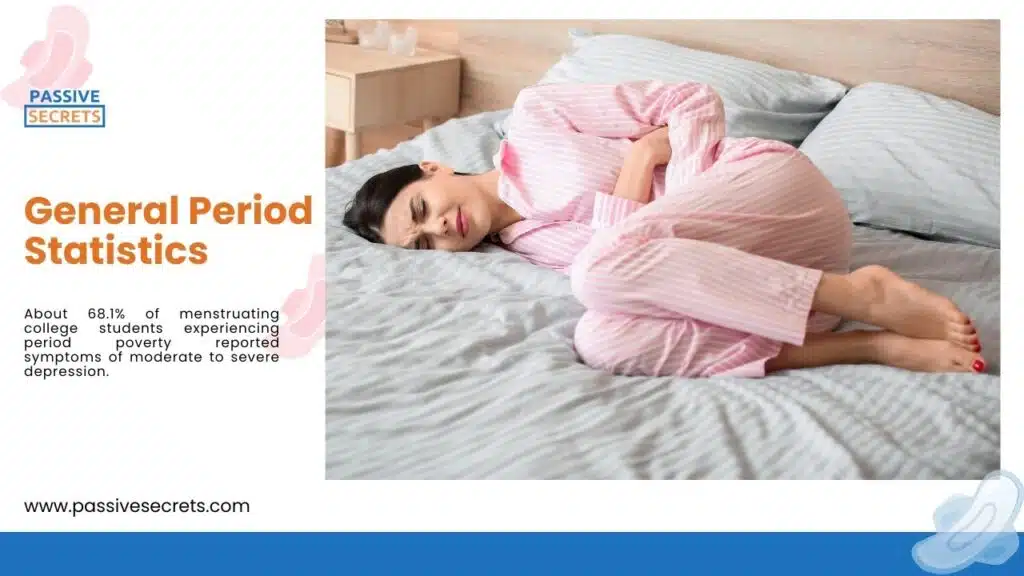
This shows a close relationship between period poverty and mental health issues. When women cannot afford menstrual products like pads and tampons, they feel the stigma that comes with periods. This stigma affects their mental health and causes them to sink into depression.
4. 61% of low-income women in the U.S. say they use rags, toilet paper, and their children’s diapers as alternatives to period care products. (source)
5. Sadly, about 1.25 billion women worldwide cannot access safe and private toilets. Also, 526 million of them don’t have toilets at all. (source)
6. About 16.9 million menstruating women in the U.S. live in poverty. Worse, two-thirds of these women couldn’t afford menstrual products and hygiene facilities in the last 12 months. Over half of them had to choose between menstrual products and food. (source)
7. 14.2% of menstruating college students in the U.S. experienced period poverty in the past 12 months. However, 10% experience it monthly. (source)
8. World Menstrual Hygiene Day is on May 28th of every year. It is held every year to raise awareness of the stigma and challenges women and girls face during their periods. These stigma and challenges take a toll on the mental, emotional, and physical well-being of women. (source)
For example, most girls are prevented from going to school. Women are also restricted from earning a living or socializing in the communities.
9. About 25% of school girls have been forced to wear double underwear or use tissues or cotton wool because they couldn’t afford pads or tampons. (source)
10. To beat period poverty in New Zealand, the government offered free menstrual products for school girls. (source)
11. In a US survey, 30% of respondents admitted to having difficulty accessing menstrual hygiene products during the pandemic due to the quarantine. 29% struggled to purchase period products, and 18.5% struggled to afford anyone at all. (source)
12. Period poverty is a worldwide dilemma, affecting many countries worldwide. Women around the world are victims of the period stigma, especially when they cannot afford the bare period care essentials. (source)
13. The social stigma of periods also affects women in advanced countries like the U.S. 58% of women admitted they are ashamed of their periods. Sadly, men contribute to the stigma. 51% of surveyed men say it is wrong and unethical to discuss periods at work. (source)
14. During the COVID-19 lockdown, period poverty worsened worldwide as suppliers and distributors stopped operating. This made period products very scarce, especially in rural areas. (source)
15. Lack of clean water or proper spaces for period management has caused women to wear sanitary pads for more extended periods. Unfortunately, prolonged use of menstrual products without changing and cleaning up properly can cause health risks like infections and bacteria. (source)
16. Some women choose pregnancy when they can’t afford proper period care products for themselves. However, this can harm them because they are exposed to maternal complications. These complications are due to poor pregnancy spacing. (source)
17. Period poverty also involves a lack of education about periods, which is also one of the leading causes of period stigma. (source)
18. People with periods use over 9,000 sanitary pads in their lifetime. (source)
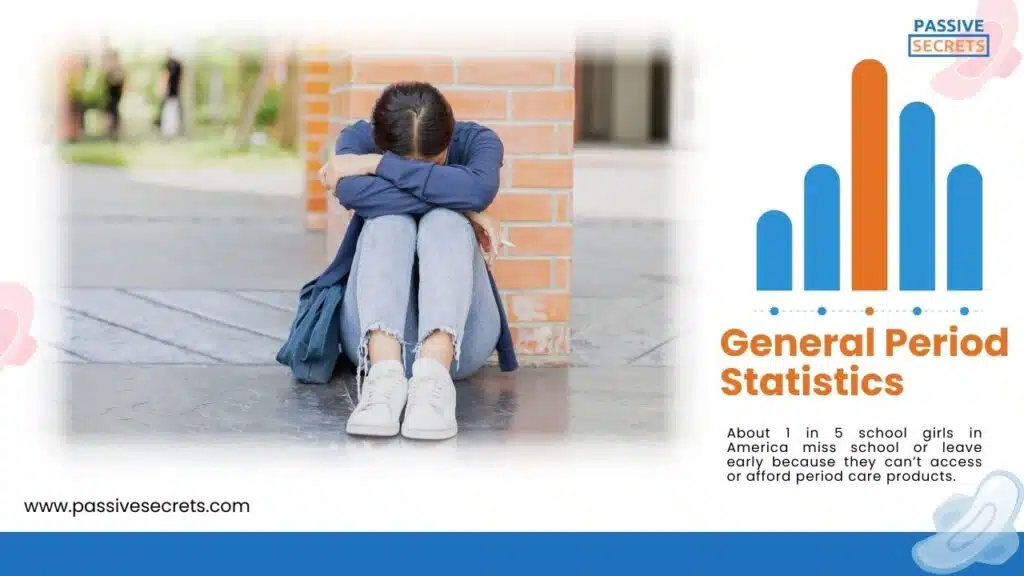
19. About 1 in 5 school girls in America miss school or leave early because they can’t access or afford period care products. (source)
20. Women are forced or persuaded to have transactional sex, where they exchange sex for sanitary pads. This transactional sex can come with consequences such as unwanted pregnancies or even slavery. Period poverty exposes young and unsuspecting women to abuse and sexual exploitation. (source)
21. Over the previous year, 64% of women could not afford necessary menstrual hygiene supplies. (source)
22. 40% of teens in the U.S. admitted to wearing period products longer than recommended because they couldn’t afford enough. 62% also say that they rarely or never find free period products in public toilets. And 23% say they struggled to afford these products. (source)
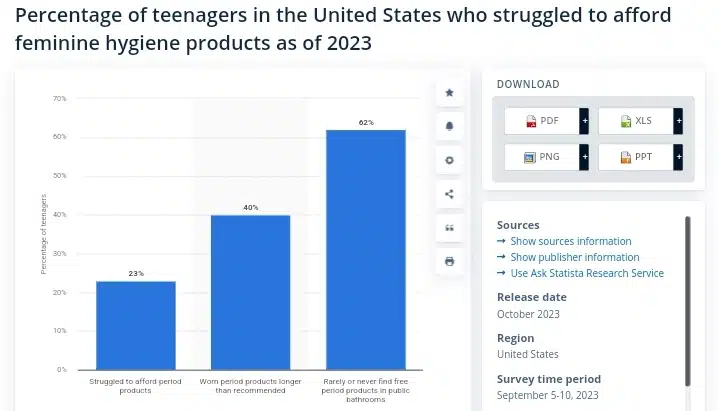
23. 88% of surveyed teens in the U.S. say they hid period products when going to the school bathroom. Also, 25% say they were unable to do schoolwork due to period poverty. (source)
24. In the same survey, 63% admitted to being overly self-conscious of periods while in school. 60% said they were unable to do school work due to period symptoms. (source)
25. Another very recent survey in the U.S. showed that nearly one in five (18.7%) menstruating college students have experienced period poverty. They have felt compelled to choose between purchasing menstrual products and meeting other personal expenses. However, 81.3% of respondents said they haven’t experienced period poverty. (source)
26. Almost half (47.6%) of college students in the U.S. either know someone or have personally struggled with accessing proper period products. (source)
27. Up to 21 states in the U.S. have a standard tax rate on period supplies called the “tampon tax.” Tennessee, Indiana, and Mississippi are the states with the highest tampon tax rates, with 7% each. Then Arkansas follows with 6.5%. (source)
According to another report, these states classify period products as “luxury goods” even though they are just bare essentials.
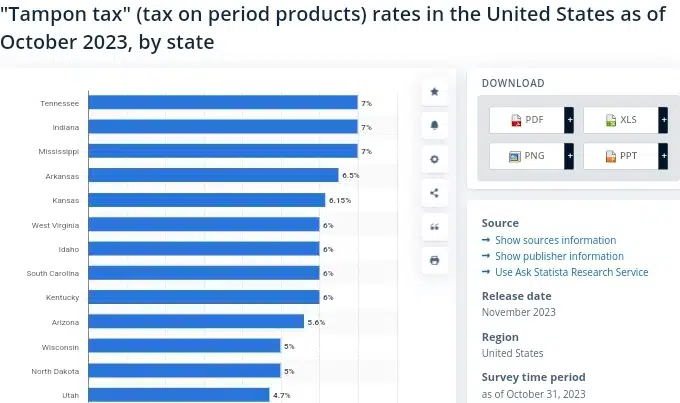
Period Poverty Statistics by Country
In India
28. About 80% of menstruating women in Bangladesh use old clothes as tampons due to period poverty. (source)
29. Another study in Bangladesh showed that menstruating women missed work for an average of 6 days in a month. (source)
30. 63% of schools in Indian villages do not educate young girls about periods. (source)
31. There is a religious belief in India that a woman on her period is “impure” and “unclean.” (source)
32. In urban India, nearly 70% of women use sanitary pads, while in rural India, only 48% do so. (source)
33. An Indian survey on menstrual hygiene showed that nearly half of the respondents (49.8%) used hygienic period protection methods. However, 22.7% continued to use unsanitary methods, and 27.5% used both hygienic and unsanitary methods during their menstruation. (source)
34. In Western Nepal, there is a tradition called “chhaupadi,” where women and girls on their periods are ostracized. They are prohibited from socializing, cooking, or living in their family home. These women are made to live outside, exposed to danger because they are seen as “filthy.” (source)
In East Asia
35. The price of sanitary pads increased by 500%, thus increasing cases of period poverty in the country. (source)
36. Plan International collaborated with Modibodi, a sustainable period brand, to empower over 5000 Asian women and girls on proper period management.
The collaboration campaign provided up to 1000 “reusable and sustainable menstrual underwear” to over 333 women and girls. About three-quarters of the participating ladies said the program made them feel more confident in period management. (source)
37. In Lao PDR, a study showed that 31.8% of young girls skipped school due to menstruation. Some of them were absent due to their very young age, menstrual anxiety, using painkillers for menstrual pain, etc. (source)
38. In Japan, periods are seen as a taboo or embarrassment. Hence, it is rarely talked about. (source)
39. 30% of surveyed Japanese women experience period poverty, which limits their ability to purchase period care products due to low income or high costs. These women also cited low income and parents’ unwillingness to get sanitary pads as other reasons. (source)
40. In China, women spend about $160 on sanitary pads yearly, with a 13% sales tax. Sanitary pads are costly in China, which can financially burden many people — especially those earning $154 per month. (source)
41. The period poverty in China is worsened by the poor quality of sanitary pads and lack of education on period management. (source)
42. In Indonesia, about 22% of women in a survey lacked access to proper period hygiene management. The period poverty the women experience is both from unavailable period products and a lack of education about periods. Some areas have minimal infrastructure like toilets and running water. (source)
In most cases, the women have to travel long distances to small kiosks just to access these products.
43. Malaysia’s period poverty issue is due to overcrowding in the country. Hence, women lack privacy for proper period management. Women are forced to share communal toilets and bathrooms with other individuals, even with poor facilities like water. (source)
In Africa
44. In Nigeria, about 25% of menstruating women lack privacy for proper menstrual hygiene management. (source)
45. Recent reports show that over 37 million Nigerian girls and women are living in period poverty. (source)
46. 24% of Nigerian school girls miss school due to period poverty. (source)
47. 65% of women and girls in Kenya cannot afford sanitary products for their periods, citing them as too expensive. (source)
48. Only 32% of rural schools in Kenya have a safe and clean space for proper period management. (source)
49. About 30% of girls in South Africa miss school during their periods because they can’t afford sanitary pads. (source)
50. According to BBC research, women earning the minimum wage in Ghana have to spend one out of every seven dollars on sanitary pads. (source)
51. In a survey of six African countries, BBC discovered that low-income-earning women spend between 3-13% of their earnings to buy two packs of sanitary pads. Looking at it, women are spending huge amounts on sanitary pads monthly. The rise in prices of sanitary pads has led women in Ghana to protest. (source)
52. In Kenya, the price of sanitary pads has fallen significantly to 50 Kenyan shillings. This is approximately 35 U.S. cents or 27 UK pence. (source)
53. In April 2019, the South African government removed the 15% value-added taxes on sanitary pads and made the pads accessible in public schools. (source)
54. However, still in 2019, the Tanzanian government reintroduced the VAT placed on sanitary products just one year after removing it. (source)
55. 95% of Kenyan girls miss 1 to 3 school days during their periods. The effect of these missed school days is that 70% of these young girls had low grades, and over 50% fell behind in school. (source)
56. 57% of surveyed young girls in South Sudan also reported staying home on their menstruating days due to no private changing rooms in school. (source)
57. A U.N. report showed that in Sub-Saharan Africa, one in every ten girls misses school during their period and eventually drops out. (source)
58. The price of sanitary pads has drastically increased in Africa. In Zimbabwe, the cost of a packet of pads has risen by 117%, while in the Democratic Republic of Congo, it has increased by 50%. Sanitary pads have more than doubled in price, rising from 5 cedis to 12 Ghanaian cedis ($1.43), and Ghana has increased its VAT on pads. The Ghana Revenue Authority classifies them as luxury items. (source)
59. One-third of South African girls between the ages of 9 and 18 are unable to attend school for several days every month during their menstrual period. (source)
60. Sadly, due to the severe financial hardship most women suffer, 16% of surveyed Kenyan girls say they rely on their boyfriends or other men for sanitary pads. The consequence of this dependence is sexual favors. Young girls are forced to exchange sexual favors for sanitary products. (source)
61. One survey showed that two-thirds of sanitary pad users in Kenya received them from sexual partners. (source)
62. 10% of 15-year-olds reported engaging in sex for money to buy pads. (source)
63. As the Ghana Revenue Authority sees menstrual pads as luxury items, the country’s government imposed an import tax of 20% and an additional 12.5% VAT on these pads. (source)
64. Over 50% of young girls in Ethiopia miss between 1 to 4 days of school monthly due to menstruation. (source)
65. In Rwanda, 15.2% of girls miss school due to menstruation, and 23.3% of women and girls miss out on economic opportunities. (source)
66. At least 20% of Rwandan schoolgirls, particularly in rural areas, miss up to 50 school days annually. Unfortunately, menstrual limitations can result in a loss of US $215 per woman annually, totaling US $115 million in Rwanda. (source)
67. As the price of period products in Rwanda is very high, 18% of women and girls are forced to miss work or school because of period poverty. Period products in Rwanda cost between Rwf 800 (approximately $0.77) and Rwf 1200 (roughly $1.15). (source)
68. The Zambian government gave free sanitary products to girls in rural areas. (source)
In Europe
69. A UK survey found that up to 26% of girls between 11 and 21 years old are embarrassed about talking to people about their periods. Also, 21% have been made to feel shame about their periods. (source)
70. Over 137,700 young girls in the UK missed school due to period poverty. They couldn’t afford proper sanitary products for their period management. About 7% of these young girls were forced to skip school during their periods. (source)
71. 6% of surveyed parents in the U.K. admitted to stealing menstrual hygiene products for their daughters when they couldn’t afford them. Also, one-fifth of the parents in the same survey say they had placed their daughters’ hygienic needs above their own needs. (source)
72. 36% of young girls in the UK between 14 and 21 years struggled to access menstrual hygiene products during the pandemic. This is equivalent to over 1 million girls in the UK who are experiencing period poverty. 73% of those without any money to afford pads used toilet paper as an alternative. (source)
73. 30% of girls who found it challenging to afford menstrual products but still bought them said they gave up food just to afford it. 23% cut back on soap and toothpaste. And 39% cut down on clothing. (source)
74. About 49.4% experiencing period poverty in France showed symptoms of depression. This is more compared to the 28.6% of women who hadn’t experienced period poverty. (source)
75. 26% of surveyed young girls between 10 and 18 years old say they skip social gatherings during their periods because they cannot afford sanitary products. Another 27% say they don’t go out at all, at least once a month, due to period poverty. And 25% say they neither visit the gym nor engage in sports during their periods. (source)
76. Within a year, period poverty in the U.K. skyrocketed from 12% to 21%. About 21% of menstruating people in the U.K. are experiencing period poverty. That is about 2.8 million people in the U.K. who lack access to period hygiene products. (source)
77. In a survey on period poverty, 41% of people experiencing it say they keep the period sanitary pads or tampons on for longer than recommended. 8% said they reuse disposable pads. Both practices are very unhealthy and can lead to severe infections. (source)
78. 37% of women experiencing period poverty in the U.K. say they used tissues or cotton wools as alternatives to sanitary pads. 13% admitted to using socks, and 9% used paper or newspaper. (source)
79. Women experiencing period poverty in the U.K. have been forced to prioritize other essentials over period products.
Every month, these women must decide on which essential to buy. With inflation, the cost of even basic needs has skyrocketed.
60% say they prioritize food over period products. 48% prioritize electricity and gas. And 24% prioritized buying period products for their dependents rather than themselves. (source)
80. 22% of young women between 18 and 24 years in the UK say they feel embarrassed during their periods. Over half (58%) say it’s because they feared having bloodstained clothes. (source)
81. In a survey of young Flemish girls between 12 and 25 years, 5% of them missed school because they couldn’t buy menstrual products. Also, 11% resorted to borrowing these products because they couldn’t afford them. (source)
82. 12% of the surveyed women couldn’t afford period products. However, the figure grew to 45% for women living in poverty. (source)
83. Scotland is the first country to give period products for free. In 2020, Scotland became the first country to ensure all period products are free and available to all. (source)
84. Before Scotland declared period products free, a 2018 survey showed that 27% of girls used sanitary products longer than their intended use time. These women wore tampons or pads for more extended periods than the recommended time due to period poverty. (source)
85. Also, Ireland is the only European country with no tampon tax. (source)
86. 79% of Austrian women said they’d like to see period products become free instead of spending roughly €3,000 in their lifetime. (source)
87. One in every three women in Austria reports that “their monthly period expenses are a financial burden for them.” Although the country has about 9 million residents, over 500,000 women live in poverty. (source)
88. In 2021/2022, Vienna distributed over 80,604 tampons and 94,960 menstrual pads for free. Also, the VAT on women’s hygiene products in Austria was reduced from 20% to 10%. (source)
89. For Germany, 23% of women admitted that the cost of menstrual products is a financial burden despite reducing VAT from 19% to 7%. (source)
90. Belgium distributed over 300,000 free menstrual pads and tampons to 500+ female prisoners. (source)
91. Women in Europe spend an average of €27,000 on menstrual hygiene products in their lifetime. (source)
92. Belgium reduced the VAT on menstrual products from 21% to 5%. However, some other countries classify menstrual products as luxury items and give high VAT on them. (source)
93. To fight period poverty in 2020, the Belgian government pledged €200,000 to make menstrual products more available. (source)
94. In a French survey, 13% of the female students admitted choosing between getting period hygiene products and other essentials like food. (source)
95. The French government pledged about €1 million to provide free period products in schools. (source)
96. Additionally, the French government declared that from 2024, sanitary products will become free for people below 25 years old. (source)
97. In 2022, a survey showed that 30% of young women in France between 18 and 24 years old couldn’t afford sanitary products due to financial difficulties. (source)
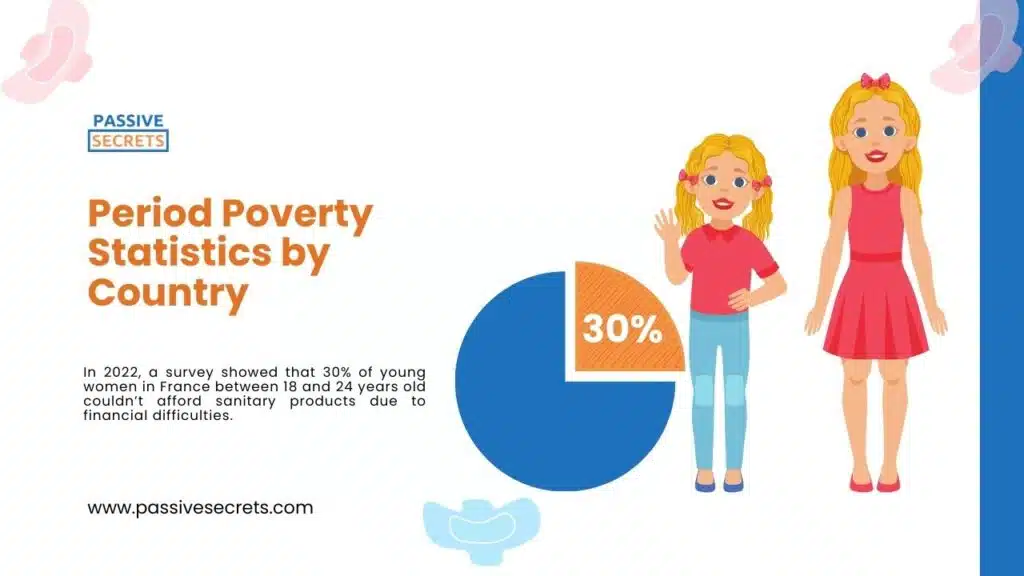
98. In 2021, the UK abolished taxes on sanitary products. (source)
Frequency Asked Questions
1. What is the Meaning of Period Poverty?
Period poverty refers to the lack of access to affordable and safe menstrual products, sanitation facilities, and education about menstrual health. This issue affects women and girls worldwide, from low-income communities to developing countries. Even developed countries like the U.S. and the UK aren’t spared.
Poverty?
According to research, Algeria is the most affected country for period poverty. In Algeria, menstrual products cost about 14.8% of a person’s monthly income.
3. What is the Main Cause of Period Poverty?
Period poverty is caused by various factors, including:
- Unaffordable menstrual products
- Poverty and lack of education
- Societal and cultural norms
- Inadequate sanitation facilities and lack of clean water
- Limited access to menstrual health information
4. Who is at Risk for Period Poverty?
Period poverty affects menstruating people in low-income communities or developing countries. It can also affect homeless women and girls, refugees, and displaced women and girls. Girls and women living in remote areas with limited access to menstrual products and sanitation facilities also risk experiencing period poverty. Then, there are women and girls from marginalized communities who face cultural or societal barriers to accessing menstrual products and information about menstrual health.
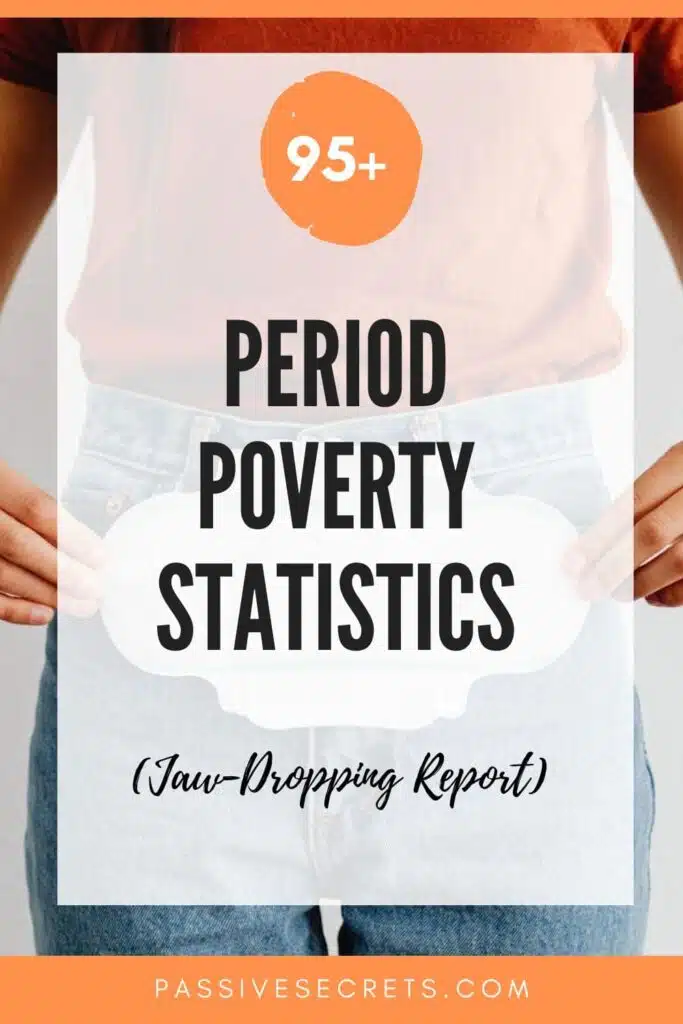
Other Related Statistics Posts:
- Thought-Provoking Gender Inequality Statistics: 160+ Insights Across Regions
- 110+ Shocking Income Inequality Data You Need to Know
- 50 Interesting Sharing Economy Statistics You Need to Know
- 100+ Animation Statistics: The Ultimate Guide To The Industry’s Trends and Insights
- 80+ Franchise Statistics and Facts You Should Know In 2024
- The Future of Learning: 50+ Top EdTech Statistics For 2024
- The Web3 Statistics Report 2024: Trends, Insights, and Predictions
- Meme Statistics 2024: Facts, Trends, and Figures That Will Blow Your Mind
- 85+ MOST Interesting Anime Statistics and Facts (NEW Report)
- Board Game Statistics: Revenue, Market Size, Demographics & More
- 125+ Interesting Airbnb Statistics by Country (Deep Insights)
- 50+ Interesting Born Into Poverty Stay In Poverty Statistics
- 90+ Interesting Film Industry Statistics (NEW Report)
- 80+ Alarming Technology Addiction Statistics You Must Know
- 65+ Impressive Chess Statistics and Facts To Know in 2024
- Spotify Statistics: Latest Report on The Music Streaming Platform
- 50+ Useful Video Game Addiction Statistics, Facts & Huge Trends
- 50+ Vital Internet Safety Statistics & Facts You Must Know
- Internet Dangers Statistics: A Look At The Internet’s Dark Side
- 50 Interesting Bible Statistics and Facts You Didn’t Know
- 95+ Interesting Dream Statistics and Facts You Can’t Miss
- 75+ Interesting Relationship Statistics & Facts You Should Know
- Dance Statistics: A Deep Dive Into The Rhythm Of Movement
- 40+ Incredible Single Father Statistics You Have to Know
- The Battle of the Sexes: Male Vs. Female Spending Statistics
- 70 Exciting Love Statistics And Facts (True Love, Intimacy, Marriage, Dating & Relationships)
- 30+ Gentle Parenting Statistics & Facts: Is This Parenting Style Worth It?
- 55+ Useful Black Consumer Spending Statistics (2024 Report)
- Holiday Spending Statistics: Valentine’s Day, Easter, Thanksgiving, & Christmas
